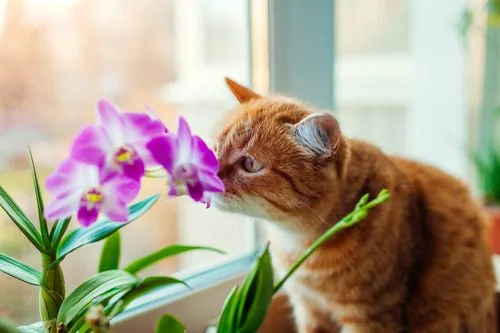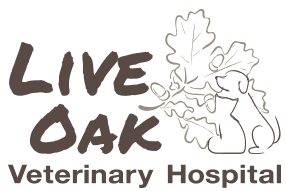Your home and garden can be a haven for your cat, offering a place of comfort and play. However, lurking within that safe space could be dangers that pet owners might not be aware of. One of these dangers comes in the form of common plants that, while beautiful, can be toxic to cats. In this blog, we’ll explore 10 plants that could pose a risk to your beloved pet, providing insights into why they’re harmful and signs of poisoning to watch out for. If you’re concerned your cat may have come into contact with any toxic plants, call Live Oak Veterinary Hospital in Sonora, CA, at 209-432-9437 or book an appointment online for expert care.

Lilies
Lilies are among the most dangerous plants for cats. Even small ingestions, such as a few petals or leaves, can cause severe kidney damage. It’s crucial to avoid keeping lilies in your home or garden if you have cats. If your cat has been exposed to lilies, symptoms can include vomiting, lethargy, and a lack of appetite. Immediate veterinary care is essential to prevent kidney failure.
Sago Palm
The Sago Palm is increasingly popular in decorations and gardens, but it’s highly toxic to cats. Ingesting even a small part of this plant can lead to vomiting, diarrhea, seizures, and liver failure. Watch for symptoms like vomiting, increased thirst, and yellowing of the eyes or skin, which could indicate liver damage.
Tulips
Tulips contain allergenic lactones and other compounds that can be toxic to cats. The bulb of the tulip is especially dangerous, causing symptoms like drooling, vomiting, and diarrhea. If a cat ingests tulip bulbs, you may also notice increased heart rate and difficulty breathing, signaling the need for immediate veterinary attention.
Azaleas and Rhododendrons
Azaleas and Rhododendrons, members of the Rhododendron species, are popular in gardens for their stunning flowers and lush foliage. However, these plants contain grayanotoxins, which can pose a significant health risk to cats if ingested, leading to toxic reactions even from consuming just a few leaves. Cats with rhododendron poisoning may exhibit vomiting, diarrhea, drooling, and lethargy. More severe reactions can escalate to loss of coordination, weakness, and in extreme cases, seizures.
Oleander
Oleander is a beautiful but dangerous shrub that’s commonly found in gardens and public spaces due to its vibrant flowers and hardy nature. However, every part of the Oleander plant is toxic to cats, containing cardiac glycosides that can interfere with the heart’s electrical system and muscle contractions. If a cat ingests Oleander, symptoms can manifest quickly and may include drooling, abdominal pain, diarrhea, and vomiting. As the toxicity progresses, more severe symptoms such as difficulty breathing, lethargy, and a noticeable change in heart rate can occur.
Dieffenbachia
Dieffenbachia, commonly known as Dumb Cane, is a popular houseplant praised for its striking, patterned leaves. However, it poses a hidden danger to our feline companions. The plant contains calcium oxalate crystals, which, when chewed or ingested, can release these sharp crystals, causing immediate pain and irritation. Symptoms may range from intense burning and irritation of the mouth, lips, and tongue, to excessive drooling, difficulty swallowing, and a significant decrease in appetite due to the pain.
Autumn Crocus
The Autumn Crocus, with its lovely purple flowers, may look inviting in a garden or home setting, but contains colchicine, a potent toxin that can cause severe health issues in cats, even from minimal exposure. Initial signs of Autumn Crocus poisoning can be subtle, including gastrointestinal upset such as vomiting and diarrhea. As the toxin’s effects become more pronounced, cats may experience severe abdominal pain, liver and kidney damage, respiratory distress, and even seizures.
Daffodils
Daffodils are a cheery sign of spring but pose a hidden danger to cats. These common flowers contain compounds such as lycorine, which is toxic to cats, causing a range of symptoms from mild to severe depending on the amount ingested. Signs of daffodil ingestion in cats can include vomiting, diarrhea, and abdominal pain, often occurring soon after ingestion. In more severe cases, symptoms can escalate to include cardiac arrhythmias, respiratory depression, and even seizures.
Castor Bean
The Castor Bean plant, while known for its attractive foliage and as a source of castor oil, presents a severe risk to cats due to the presence of ricin, a highly toxic compound. Ricin can cause severe illness and, in some cases, fatal consequences if ingested by cats. After ingesting parts of the Castor Bean plant, cats may exhibit symptoms such as loss of appetite, abdominal pain, vomiting, and diarrhea, which may become bloody. Severe cases can quickly progress to dehydration, tremors, seizures, and organ failure. The rapid onset of symptoms underscores the need for immediate veterinary attention.
Yew
Yew, an evergreen shrub commonly found in gardens and landscapes, poses a serious risk to cats due to its toxic components. All parts of the Yew plant, especially the seeds contained within the berries, contain taxine, a compound that can cause rapid and severe effects on the cardiac system of cats. Symptoms of Yew poisoning can include vomiting, difficulty breathing, and sudden weakness, followed by potentially fatal cardiac abnormalities such as arrhythmias.
Keeping Your Cat Safe
Ensuring your home and garden are safe for your cat involves understanding the risks posed by certain plants. Always research before introducing a new plant into your cat’s environment. If you suspect your cat has ingested a toxic plant, contact Live Oak Veterinary Hospital immediately. Early intervention is key to preventing serious health issues. Remember, your cat relies on you for its safety and well-being. By being aware of the plants mentioned above and acting quickly in case of exposure, you can help keep your cat healthy and happy. Give us a call at 209-432-9437 or book an appointment online to ensure your pet receives the best possible care.
